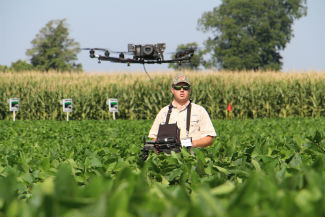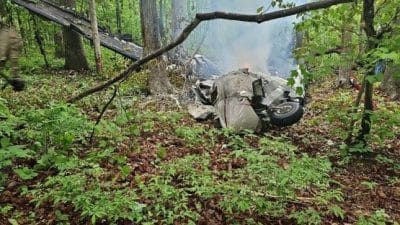
On the farm of the future, drones will fly over forests and crops to communicate with robots embedded in harvesting equipment on the ground. Sensors on livestock and in field crops and forest lands will be linked to the cloud where big data is transformed into practical information regarding precision feeding, protection, and management decisions. Plants will be biodesigned to require less water and fertilizer, and be tolerant to drought, pests, and floods while producing more food. Farmers will operate their businesses with iPads as much as tractors.
This is the farm of the future, and Virginia Tech is leading the charge to help producers maximize efficiency while sparking a new agricultural and natural resources economy.
The university is creating the SmartFarm Innovation Network, a decentralized network of interconnected centers across the commonwealth. Virginia Tech’s interdisciplinary researchers and Virginia Cooperative Extension specialists and agents will partner with producers and the commercial sector to develop and deploy a wide array of innovative technologies that will increase overall efficiency, resilience, and sustainability of agricultural and natural resources production systems.
“The SmartFarm Innovation Network is about more than just harnessing the latest technology available to help producers succeed in a changing world,” said Alan Grant, dean of the College of Agriculture and Life Sciences. “It’s a deliberate way to create an environment in which the commonwealth’s largest industries — agriculture and forestry — can thrive and remain global leaders for decades to come while also contributing to the economy and health of local communities.”
The SmartFarm Innovation Network is made up of about 120 interconnected locations — the Blacksburg campus, 11 Agricultural Research and Extension Centers, and 108 Virginia Cooperative Extension local unit offices — where the technologies of tomorrow are being developed, tested, and implemented today. The network leverages the university’s existing infrastructure to capitalize on its proximity to agricultural and natural resources industries around the commonwealth and on the state’s soil, climate, and geographic diversity.
Agriculture and forestry are the commonwealth’s largest private industries and have an annual economic impact of more than $91 billion. The network is being designed not only to help those industries grow but also to capitalize on advances in science and technology. Virginia Tech recently announced it was launching an Innovation Campus in Alexandria, Virginia, which will have an initial focus on computer science, computer engineering, and related disciplines. The SmartFarm Innovation Network takes advantage of that growth and uses the knowledge and partnerships created in Alexandria in applications that will serve agricultural and natural resources communities.
“The SmartFarm Innovation Network is poised to leverage the university’s expanding talent pipeline, including the Innovation Campus,” said Tim Sands, president of Virginia Tech. “It is an example of how investments in talent and partnerships can be employed to accelerate development in rural locations around the state. Using knowledge developed by Virginia Tech to foster prosperity around the commonwealth is at the heart of our land-grant mission.”
This network of centers will work with industry to commercialize technologies that address challenges in the areas of environment, policy, workforce development, and more.
Teams of interdisciplinary researchers will develop systems and technologies that meld agricultural and natural resources production systems with biodesign, biomaterials, big data, artificial intelligence, and cybersecurity. The network will connect researchers, Extension agents, producers, business, and others in a system that allows for faster exchange of information and robust data analysis. Data regarding soil conditions, weather, and pest advisories will be streaming from around the state and turned into information that producers can use to make real-time informed decisions in their specific geographic region. It will also allow consumers to harness this information to source their food.
Industry partners will be able to tap into this network of innovation by using the network as an incubator for launching new products to help agriculture and natural resources remain the largest private sectors in the state.
The idea for the network came from the April 2018 Virginia Agriculture and Natural Resources Summit, which brought together stakeholders to discuss solutions and identify resources needed to create jobs around the commonwealth, increase value for stakeholders, and develop a strong workforce. Among the ideas that emerged from two days of dialogue were the need to develop innovative technologies for farms, public lands, and resource management; increase networking opportunities between the agriculture and natural resources industries and Virginia Tech; address workforce challenges in these sectors; expand partnerships among the university, agriculture and natural resources industries, and government; and develop a more modern transportation infrastructure for the agriculture and natural resources industries. The SmartFarm Innovation Network is the first of many responses to those calls to action.
The SmartFarm Innovation Network will be a portal into all the expertise that Virginia Tech has to offer, as well as a platform for collaboration that turns ideas into action. Undergraduate and graduate students will also have access to the network through experiential learning and research opportunities. Plans are underway to further develop a curriculum for students that will create a workforce that is prepared to work in SmartFarm-related fields.
Industry stakeholders see value in the network through the opportunity to partner with the university and increase their own economic footprint.
“Core to Novozymes’ purpose is connecting with partners to solve the world’s biggest problems, such as food security for a growing global population,” said Chris McDowell, head of operations at Novozymes Biologicals Inc. in Salem, Virginia. “A Virginia Tech SmartFarm Innovation Network that is well-funded and has a wide scope would be an excellent resource to help us realize this purpose.”
While new funding from the state and partnerships with private businesses are still needed to realize the full potential impact of the network, there are many research and Extension projects already underway that can pave the way for further growth.
Animal and poultry sciences Assistant Professor Robin White is working with a team of mechanical engineers to create a “rumen robot,” a microscopic device inside of beef cattle that takes measurements of the animals’ nutrient intake. White then uses these data to create algorithms to build individualized diets that facilitate optimal growth and health while reducing waste. This also decreasing the amount of greenhouse gases emitted from the animals.
Song Li, a crop and soil environmental scientist who specializes in bioinformatics, is developing an autonomous robot that moves through crops and takes growth measurements using Lidar technology. These data are then transmitted to drones flying overhead that relay information to producers who can make informed decisions about crop inputs based on the data.
At the Alson H. Smith Jr. Agricultural Research and Extension Center, in Winchester, Virginia, Professor Tony Wolf has worked with personnel at Virginia Tech’s Center for Geospatial Information Technology to build and refine a series of vineyard site evaluation Geographical Information System tools, the current iteration of which is called GeoVine. The web-based GIS tool allows prospective grape producers to assess the climatological and physical features of a parcel of land as part of the site evaluation process.
Plant geneticist Bo Zhang is collaborating with an interdisciplinary team of geneticists, food scientists, bioinformatic scientists, horticulturalists, entomologists, plant pathologists, and agricultural economists to breed soybean varieties used for edamame that can grow in Virginia. The project will open a new market for farmers and meet the increasing U.S and export demands for edible soybeans.
At the Eastern Virginia AREC, Superintendent Joseph Oakes is flying drones over grain crops to measure soil moisture and nutrient density in order to predict and examine the spread of a blight that impacts wheat and barley. This will more accurately depict disease resistance and the efficacy of fungicide and varietal selection, which will help producers save time and money.
Sue Duncan, a food scientist and assistant director of the Virginia Agricultural Experiment Station, led a team of researchers who is exploring cyber biosecurity in the food system, from food production to the end product user. Her team is finding that awareness, knowledge, adoption, and frequent evaluation of cyber biosecurity plans and strategies among and within all food and agricultural sectors is essential.
Each of the 11 Agricultural Research Experiment Stations, in addition to the Urban Horticulture and Turf Grass Centers in Blacksburg, have installed on-site weather-intelligence provider WeatherSTEM systems to measure wind speed and direction, precipitation, temperature, humidity, and solar radiation. In addition, high-resolution cameras connected to the cloud record real-time imagery of current conditions and can provide time-lapse visuals of weather patterns.
Data from the monitoring devices is transmitted to the WeatherLink Cloud where it is available for immediate viewing on the AREC WeatherSTEM websites or via a mobile app that is downloadable from the website. As a result, producers, residents, researchers, and members of the public can access up-to-the-minute weather information, including sky cam images, and receive weather alerts about such phenomena as lightning, including when it is coming and how far away it is.
To continue developing the SmartFarm Innovation Network across the state, new faculty members will be hired to join interdisciplinary teams that can address the wide range of issues important to the agriculture and natural resource communities.
“The formation of the SmartFarm Innovation Network is just the beginning,” Grant said. “We want to lead the way toward a new Virginia economy that will help our producers capitalize on the technological advances that are changing our world.”










